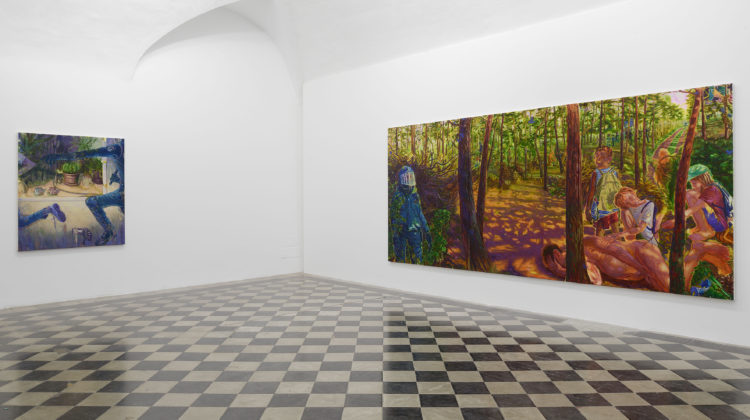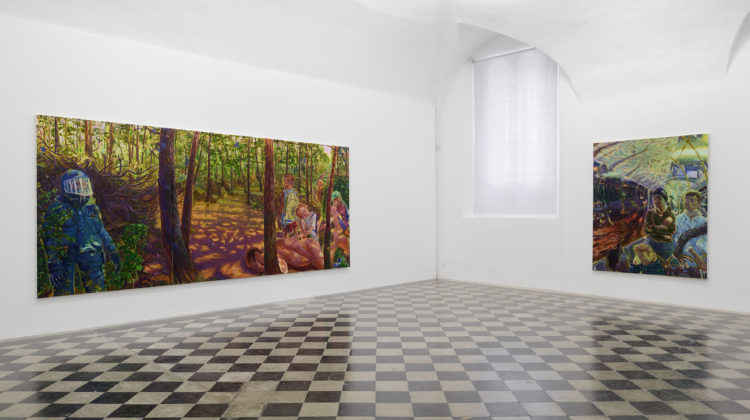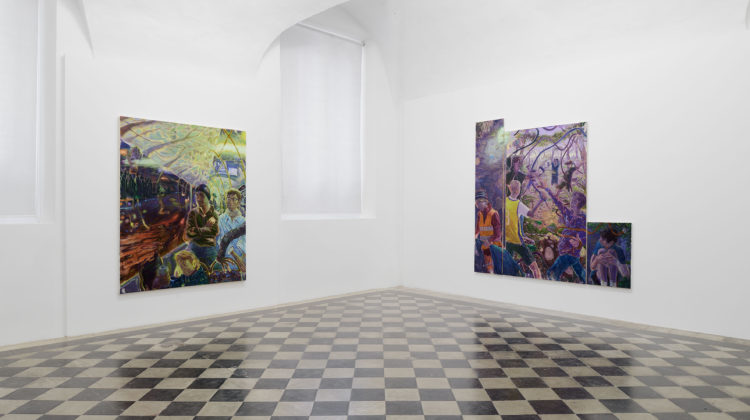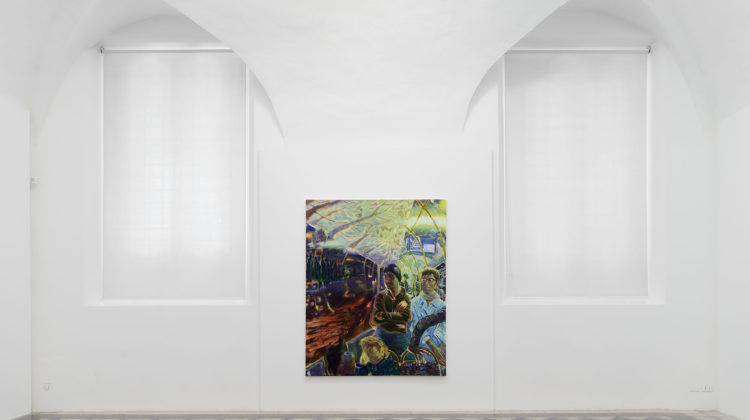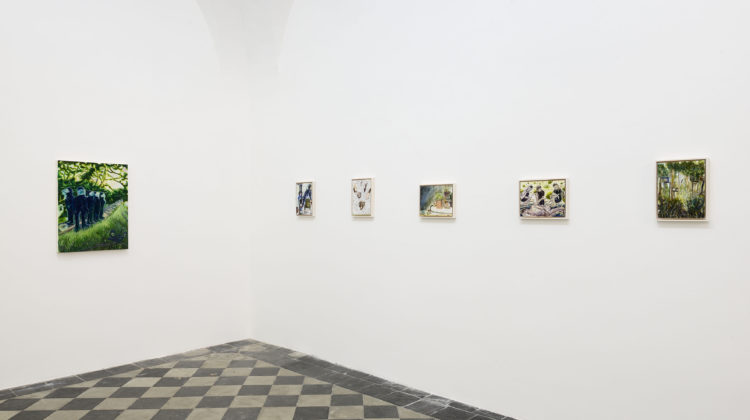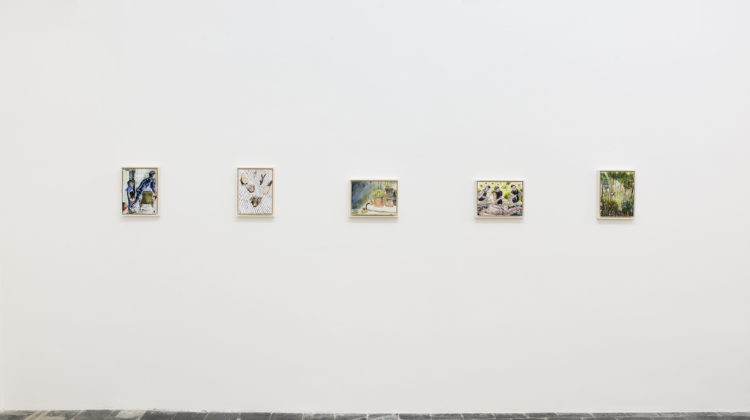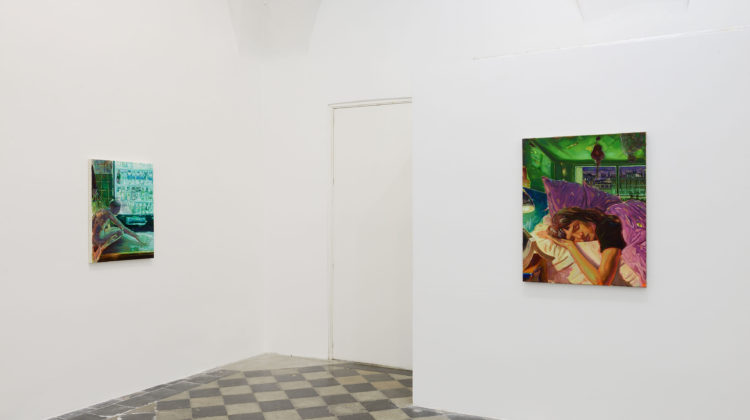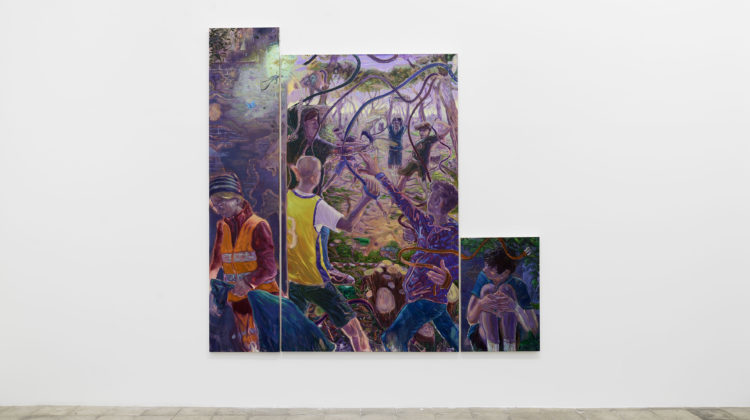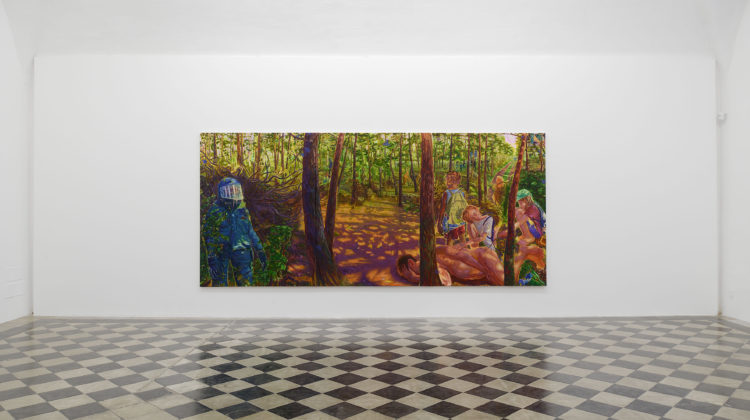1/9unosunove is pleased to announce the opening of
Pietro Moretti
Selve
Curated by Simone Zacchini
To lose yourself: a voluptuous surrender, lost in your arms, lost to the world, utterly immersed in what is present so that its surroundings fade away. In Benjamin’s terms, to be lost is to be fully present, and to be fully present is to be capable of being in uncertainty and mystery. And one does not get lost but loses oneself, with the implication that it is a conscious choice, a chosen surrender, a psychic state achievable through geography.
REBECCA SOLNIT, A Field Guide to Getting Lost (2005)
The new works that compose Pietro Moretti’s (Rome, 1996) latest exhibition project – his first solo show in his hometown, hosted by 1/9unosunove – arise from reflections on the uncanny and the wonder of contemporary urban life. In particular, the interplay between the authoritarian power of civilization and the irreducible force of nature, intimate yet simultaneously alien. Within this knot of irresolvable paradoxes, weeds and butterflies, cold lights and violence, the body is lost: an ever more dematerialized bastion and threshold of the possibilities of knowledge, even in its most obscure and undesirable forms.
The bodies in Moretti’s work – undisciplined, fierce and tired, alienated in a hypnagogic state that also assumes tender and awkward accents, when not outright humorous – are embedded in a microcosm of lost (or losing?) stories in the forests of contemporaneity. Echoing Foucault, these bodies may simultaneously act as instruments of power, resistance, and experimentation. Yet this expanded universe of possibilities makes them even more unstable and inconsistent, divided between the explicit brutality of the real world to which they belong and the aesthetic affability of an imaginary universe in which they would like to find refuge. With this sense of complexity in mind, Moretti aims to create a site-specific pictorial intervention of environmental dimensions, almost on a one-to-one scale, in which the viewer sinks physically within a narrative and visual imaginary which is seamless, as in a kind of pictorial cyclorama, articulated by composite canvases. Stories, characters and details intertwine, and recur several times in different situations, united by a cohesive visual scenario: the “forest”, which materializes the dialogue between real and imaginable worlds.
Indeed, all the oil-painted canvases displayed in the first room are precisely conceived within a forest. Beyond the immediate Dantean reference, the ‘forest’ may recall a sonnet by Vittorio Alfieri in which the poet’s mind metaphorically finds refuge in the forest, “rewilding itself” (“si rinselva” Tacito orror di solitaria selva, 1786). Declined in various nuances, as the plural chosen for the title immediately suggests, Moretti’s “forests” are metamorphic settings: they feature clear realist references (woodlands, parks, even cityscapes as “urban jungles”), intertwined with both figurative meanings (a dense, intricate, and confusing multitude) and symbolic ones, where the forest becomes a fairy-tale landscape, a place of escape and concealment, mysterious and alluring. Opposed to the city, it illuminates — as the indispensable Henry David Thoreau teaches —different ways of living and thinking.
As in the forest itself, all the paintings on display feature a coexistence of realistic and imaginary elements, where myth and fairy tale merge with the mental projections of the characters and their stories. A similar imaginary echoes in the second room, with smaller format canvases and watercolors on paper. Through surprising, at times even dissonant juxtapositions, these works act as a counterpoint to the main narrative, like a visual transposition of an ensemble of scattered notes (another possible figurative definition of “selve”), a creative tool widely used by Moretti in his painting process.
The original idea for the exhibition stemmed from a journalistic photo showing a formation of policemen in riot gear immersed alone—seemingly facing no threat—in the idyllic nature of Berlin’s Volkspark Hasenheide. Berlin is the city Moretti moved to some time ago, and many details in the paintings refer back to it. The absurd juxtaposition of the rigid formation of law enforcement with the anarchic vitality of the forest reflects the paranoid and contradictory political climate of these last years, within which the events depicted in the paintings unfold.Closely tied to its context of creation, yet so distant from it, Moretti’s painting does not attempt to solve or offer answers; on the contrary, his visual alphabet further articulates the representation, situating it within a temporal collapse where multiple stories from different eras intertwine with the rhythm of vegetation. Fragile, yet at the same time powerful compositions, where the post-adamic natural condition and the resulting civilization cannot but confront themselves with the dimension of violence, even in subtle and implicit forms. The exit from the garden of delights leads into the forest, into shame (as in the direct visual quotation to the biblical episode of Noah’s drunkenness), but also into the discovery of the self in relation to a world that is no longer perfect —an extremely complex world in which it is easy to become lost.
The characters who inhabit the exhibition hover between the desire to escape reality – unable to find their place in it – and the attempt to reshape it, still undecided whether to accept defeat or rebel against this factual condition emblematic of their existential state. Their actions appear crystallized in a state of suspension, between something about to happen and something that has already occurred: a condition of waiting and disorientation, of bodies lost in different ways, in different worlds. In these paintings the melancholic viscosity of memory is mixed with the ephemeral, artificial nature of reflections in shops’ or bus’ windows. Thus Moretti’s characters, enveloped by artificial city lights or the natural ones filtered through branches, move through the carefully orchestrated glaring delusions of the “pipe pipers” of propaganda.
The paintings on show suggest ambivalent interpretations, mirroring the dialogue between the natural imagery of the forest and the constructed one of the city. Both these places may be understood as spaces of ungovernability, illusion, and deception, where anxiety, fear, and loneliness intertwine, and where everything lives in a continuous exchange between form and formlessness, nudity and occlusion, between being a prey and a predator.
By weaving together references from his everyday life, his own experience, and the stories of those around him, with more or less explicit nods to the history of painting (Giovanni Bellini, Carl Spitzweg) and literature (Horacio Quiroga, the Brothers Grimm, James Graham Ballard) – Moretti, in his works, puts in dialogue the plane of reality with its imaginary projections. With his multifaceted brushwork, he seeks a form of figuration that distances itself from the mere factual reproduction of the real, while remaining deeply steeped in it and in its contradictions. The artist aims to establish a disorienting relationship with the viewer, who is confronted with an intricate painting that prompts reflection on the feeling of being lost as a necessary condition for self- knowledge.
Simone Zacchini
Pietro Moretti (Rome, 1996) currently lives and works in Berlin. In 2020 he graduated from the Slade School of Fine Art, University College London. Among his solo exhibitions: Il falò dei gonfiabili, Collezione Iannaccone (Milan, 2023); Le storture del cactus, Galleria Doris Ghetta (Milan, 2023). He has participated in numerous group shows, including: Le cose che non sappiamo, Galerie Romero Paprocki (Paris, 2024); When in Rome, AlbumArte (Rome, 2024); Inneres Auge, Galerie Mazzoli (Berlin, 2024); Drive Me Acid, Museo Laboratorio di Arte Contemporanea (Rome, 2024); Sensing Painting, Castello di Rivoli (Turin, 2023); Pittura italiana oggi, Triennale (Milan, 2023); Shipping Address, Palazzo Monti (Brescia, 2023); Figure Out, 1/9unosunove (Rome, 2022); Post fata resurgo, Spazio Amanita (Florence, 2021). He has participated in awards and residencies including: Palazzo Monti (2023), Sicily Artists Residency Program (2020), and the Robert Ross Price (2020). His works are part of important public and private collections such as Castello di Rivoli Museo d’Arte Contemporanea (Turin) and the Collezione Giuseppe Iannaccone (Milan).
Download here Full Documentation
